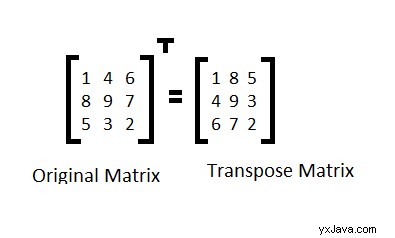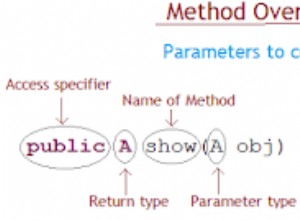Programme Java pour afficher la transposée d'une matrice
Dans ce tutoriel, nous allons apprendre à afficher la transposée d'une matrice. Mais avant d'aller plus loin, si vous n'êtes pas familier avec les concepts du tableau, alors consultez l'article Tableaux en Java.

Entrée : Saisissez les éléments de la matrice :
1 2 3
4 5 3
9 3 2
Sortie : Transposer La matrice est :
1 4 3
2 5 3
3 3 2
Programme 1 :Afficher la transposée d'une matrice
Dans ce programme, nous utiliserons une matrice séparée pour stocker les éléments de transposition.
Algorithme
- Démarrer
- Déclarez des variables pour les lignes et les colonnes de la matrice.
- Demandez à l'utilisateur d'initialiser les lignes et les colonnes.
- Déclarez une matrice.
- Demandez à l'utilisateur d'initialiser les éléments de la matrice.
- Imprimez la matrice d'origine.
- Déclarez une autre matrice qui stockera l'élément de matrice de transposition.
- Stockez les éléments dans la matrice de transposition en modifiant les lignes et les colonnes de la matrice d'origine.
- Afficher la matrice de transposition.
- Arrêtez.
Vous trouverez ci-dessous le code correspondant.
Le programme ci-dessous montre comment trouver la transposition d'une matrice.
/*JAVA PROGRAM TO DISPLAY THE TRANSPOSE OF A MATRIX*/
import java.util.*;
public class Main
{
public static void main(String []args)
{
///Take input from the user
Scanner sc=new Scanner(System.in);
int m,n; //Matrix Size Declaration
System.out.println("Enter the number of rows: \n");
m=sc.nextInt(); //Matrix Size Initialization
System.out.println("Enter the number of column: \n");
n=sc.nextInt(); //Matrix Size Initialization
int arr[][]=new int[10][10]; //Matrix Size Declaration
System.out.println("Enter the elements of the matrix: ");
for(int i=0;i<m;i++) //Matrix Initialization
{
for(int j=0;j<n;j++)
{
arr[i][j]=sc.nextInt();
}
}
//Print the original Matrix
System.out.println("The elements in the original matrix are: ");
for(int i=0;i<m;i++) //Print the matrix
{
for(int j=0;j<n;j++)
{
System.out.print(arr[i][j]+" ");
}
System.out.println("");
}
int brr[][]=new int[10][10]; //Transpose Matrix Declaration
for(int i=0;i<m;i++) //Transpose Matrix initialization
{
for(int j=0;j<n;j++)
{
brr[j][i]=arr[i][j]; //Store elements in the transpose matrix
}
}
System.out.println("After transposing the elements are...");
for(int i=0;i<m;i++) //Print the transpose matrix
{
for(int j=0;j<n;j++)
{
System.out.print(brr[i][j]+" ");
}
System.out.println("");
}
}
}
Entrez le nombre de lignes :3
Entrez le nombre de colonne :3
Entrez les éléments de la matrice :5 4 3 1 2 6 9 8 7
Les éléments de la matrice originale sont :
5 4 3
1 2 6
9 8 7
Après transposition, les éléments sont...
5 1 9
4 2 8
3 6 7
Programme 2 :Afficher la transposée d'une matrice
Dans ce programme, nous utiliserons la même matrice mais lors de l'impression nous modifierons la position des éléments.
Algorithme
- Démarrer
- Déclarez des variables pour les lignes et les colonnes de la matrice.
- Demandez à l'utilisateur d'initialiser les lignes et les colonnes.
- Déclarez une matrice.
- Demandez à l'utilisateur d'initialiser les éléments de la matrice.
- Imprimez la matrice d'origine.
- Pour imprimer la matrice de transposition, modifiez les positions des lignes et des colonnes.
- Afficher la matrice.
- Arrêter
Vous trouverez ci-dessous le code correspondant.
Le programme ci-dessous montre comment afficher la transposition d'une matrice sans utiliser d'autre tableau.
/*JAVA PROGRAM TO DISPLAY THE TRANSPOSE OF A MATRIX*/
import java.util.*;
public class Main
{
public static void main(String []args)
{
///Take input from the user
Scanner sc=new Scanner(System.in);
int m,n; //Matrix Size Declaration
System.out.println("Enter the number of rows: \n");
m=sc.nextInt(); //Matrix Size Initialization
System.out.println("Enter the number of column: \n");
n=sc.nextInt(); //Matrix Size Initialization
int arr[][]=new int[10][10]; //Matrix Size Declaration
System.out.println("Enter the elements of the matrix: ");
for(int i=0;i<m;i++) //Matrix Initialization
{
for(int j=0;j<n;j++)
{
arr[i][j]=sc.nextInt();
}
}
//Print the original Matrix
System.out.println("The elements in the original matrix are: ");
for(int i=0;i<m;i++) //Print the matrix
{
for(int j=0;j<n;j++)
{
System.out.print(arr[i][j]+" ");
}
System.out.println("");
}
//Print the transpose matrix without creating any new matrix
System.out.println("After transposing the elements are...");
for(int i=0;i<m;i++)
{
for(int j=0;j<n;j++)
{
System.out.print(arr[j][i]+" ");
}
System.out.println("");
}
}
}
Entrez le nombre de lignes :3
Entrez le nombre de colonne :3
Entrez les éléments de la matrice :9 8 7 6 7 2 3 1 3
Les éléments de la matrice originale sont :
9 8 7
6 7 2
3 1 3
Après transposition, les éléments sont...
9 6 3
8 7 1
7 2 3



